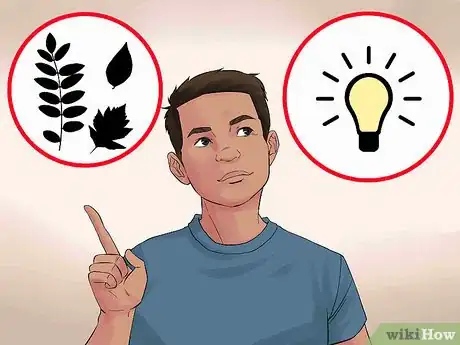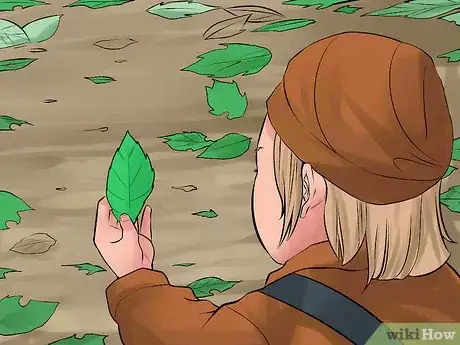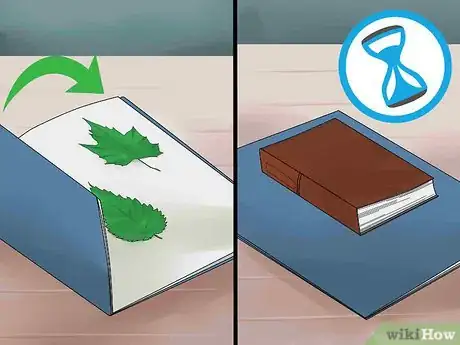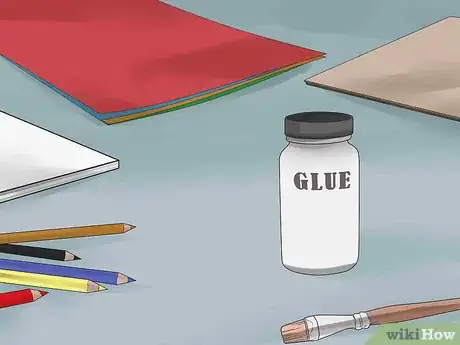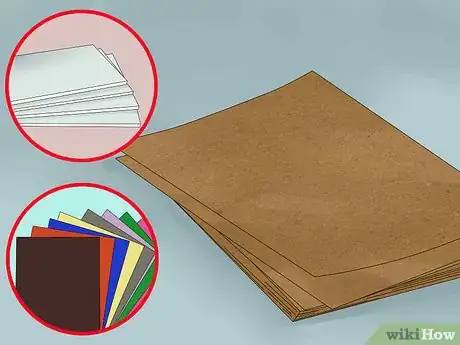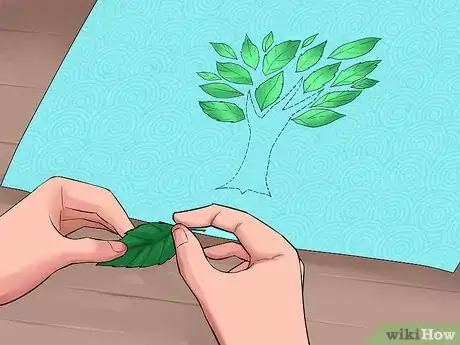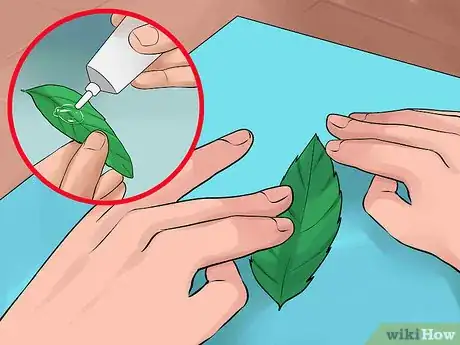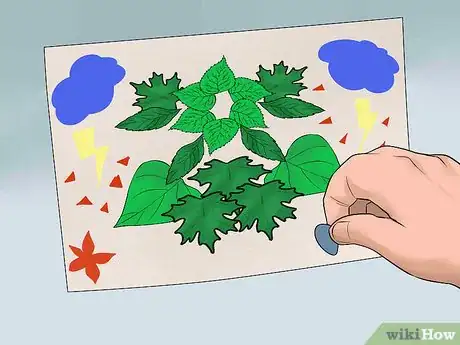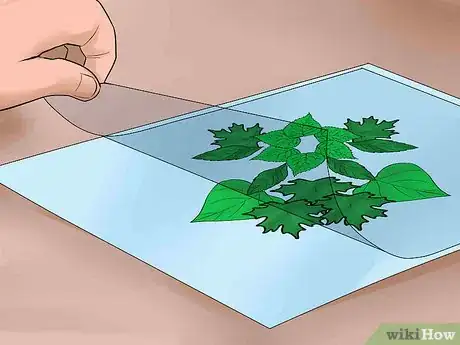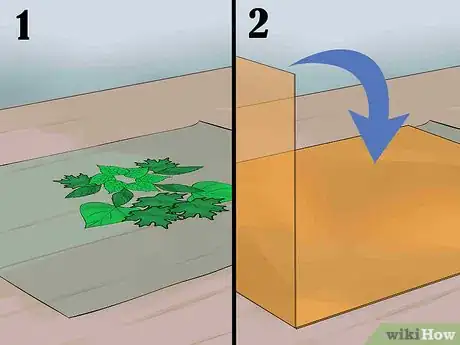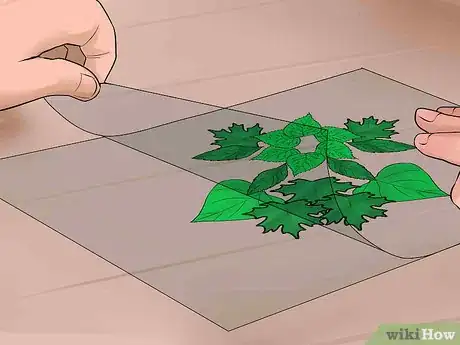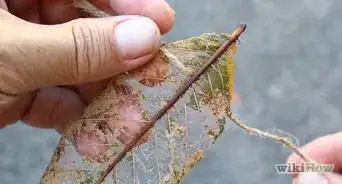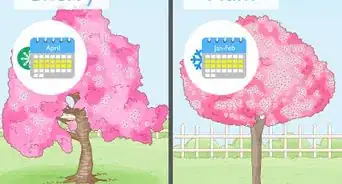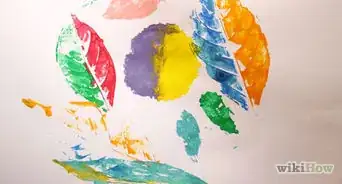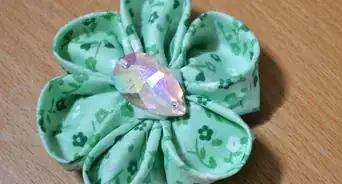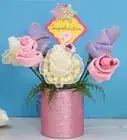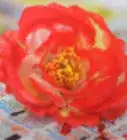This article was co-authored by Claire Donovan-Blackwood. Claire Donovan-Blackwood is an Arts & Crafts Specialist and CEO of Heart Handmade UK, a site dedicated to helping people live a happy, creative life. With over 13 years of experience, Claire uses art as a form of therapy and focuses on mindfulness in the making of art. She makes crafting easy and accessible for those she works with. Claire received her B.A. in Photography & Visual Imagery from The University of Huddersfield.
This article has been viewed 37,378 times.
Leaf collages are a great way to bring the outdoors indoors, celebrate the changes in seasons, and develop fine motor skills in young kids. This could be done as a science project, art project, or just a fun way to pass the afternoon. There’s plenty of room for creativity here, so the materials you use and the designs you use are entirely up to you.
Steps
Gathering Leaves and Supplies
-
1Decide on a theme. Before you go out looking for leaves, ask yourself what type of collage you'd like to make. Do you just want to make something pretty? Or do you want to make it informative? Decide between making an art project or a science project so you know what leaves to look for, how many you'll need, and whether you want to include stems or just the leaves themselves.
- For a science project, you could try to collect a leaf from every type of tree that grows in your area. Or you can try to find find leaves from different individual trees of the same type to show the difference between the size of a sapling's leaves versus a full grown tree's.
- For an art project, you can a landscape with leaves standing in for trees, with the leaf's stem standing in for a trunk. You could also make a wreath with lots of layers and differently colored leaves. For a landscape, you only need a few. For a wreath, the more the better!
- To identify specific types of leaves, there are plenty of field guides you could use, as well as websites like https://www.arborday.org/trees/whattree/.
-
2Go hunting for leaves. Take a stroll outside. If you live in a woodsy environment with lots of trees right outside your door, great! If not, visit a local park or any buildings with landscaping or potted trees outside. Look for whole leaves without any tears, holes, or diseased spots.[1]
- You want to keep your leaves as pristine as possible, so don’t stuff them in your pockets or a bag. Bring a manila folder, notebook, or something similar to slide them inside without folding them over.
- If it’s spring or summer, search the trees and pluck the leaves directly from their stems.
- If it’s autumn, search the ground, too, but avoid damp leaves if possible, since these may smell a little funky and start decaying faster than dry leaves.
Advertisement -
3Press your leaves. This isn’t a must, so if you like the look of curled leaves (or if they’re so dry and brittle that they’re more likely to crumble), feel free to skip it. But if you’d like your leaves to be flat as possible so they make full contact with the paper that you’ll be sticking them to, wait a couple days before making your collage. In the meantime, once you bring your leaves home, do the following:[2]
- Lay your leaves as flat as possible inside a manila folder or between sheets of paper that you don’t mind getting a little damp or dirty, like old newspapers.
- Place a heavy object with a flat bottom on top of them, like a big, thick hardcover book or a stack of board games.
- Give your leaves a couple of days to flatten under the weight.
Expert AnswerQWhen asked, “How do you make a leaf collage?”
Claire Donovan-Blackwood is an Arts & Crafts Specialist and CEO of Heart Handmade UK, a site dedicated to helping people live a happy, creative life. With over 13 years of experience, Claire uses art as a form of therapy and focuses on mindfulness in the making of art. She makes crafting easy and accessible for those she works with. Claire received her B.A. in Photography & Visual Imagery from The University of Huddersfield.Arts & Crafts Specialist
 EXPERT ADVICEAnswer from Claire Donovan-Blackwood:
EXPERT ADVICEAnswer from Claire Donovan-Blackwood:Claire Donovan-Blackwood, the owner of Heart Handmade UK, responded: “Start by gathering different types of leaves. If you want a flat collage, dry the leaves between two paper towels in the pages of a super heavy book. Put a heavy object on top and leave it. When the leaves are dry, use a water-based glue like Mod Podge to arrange and secure the leaves.”
-
4Pick your craft materials. There’s no one way to make a leaf collage, so explore your options! Choose whatever you think would be prettiest, easiest, and/or the least messy to work with. You can use:
Gluing a Collage
-
1
-
2Decide on a design. Before you start gluing leaves in place, know exactly where you want them so you don’t second-guess yourself after it’s too late to move them! Lay your backing paper down and arrange your leaves however you please. You could try:[7]
- Grouping them by the type of tree they came from.
- Creating a wreath.
- Making a landscape with leaves standing in for trees.
-
3Color in your background if you like. If you only have plain craft paper or cardboard to work with as backing, consider sprucing them up by painting them or adding other touches of color before you begin gluing. Or, even if you’re using colored construction paper or backing boards, think of other elements that you may want to include behind your leaves. For instance:
- If you’re making a wreath, you can trim sheets of other colored paper (or use crayons or markers to color in plain white paper) into thin strips. Arrange these like sunbeams pointing outward from where your leaves will go and then glue them into place.
- If you’re making a landscape, you can draw other features in the background, like buildings, mountains, or a setting sun.
-
4Glue your leaves to the backing paper. Once you have touched up your background, attach your leaves to the paper. First, decide between using liquid glue or a glue stick. Then stick each leaf to the paper.[8]
- If you’re using liquid glue, apply a thin bead around the back of your leaf. Keep a little distance between the glue and the leaf’s edges. This way the glue won’t squirt out from underneath when you stick it to the paper.
- A glue stick can be a neater alternative, since it’s transparent and won’t goop up anywhere. Rub it onto the back of the leaf, the paper itself, or both, and then press the two together.
-
5Add some finishing touches. This isn’t a must, so if you’re happy with your collage as it is, feel free to call it day! But there’s plenty you could do to spruce your collage up even more. For instance:
- If you’ve grouped your leaves together by type, consider labeling. You can use pens or markers to write the type of tree directly on the backing paper where there’s room. Or you can glue separate labels written on a different colored paper so they’ll stand out even more.[9]
- If you’ve made a landscape, you can still draw in features like grass, clouds, or the sun or moon where space allows. You can even glue other materials to the backing paper for these, like green yarn for grass or cotton balls for clouds.
- You could also apply spray-on glue to the whole thing once you’re finished. This will help preserve the leaves’ original shapes and colors.[10]
- Glitter, stickers, and similar materials can also be added to make your collage even more eye-catching.
Using Contact Paper
-
1Decide how to use it. Contact paper comes in transparent sheets, each with a sticky adhesive side. This makes it a great protective cover for flat collages, plus it can also be used instead of glue! You can either use it to:
- Seal a finished glued collage.
- Stick leaves and other materials directly to it.
- Create a collage that’s totally transparent except for the leaves.[11]
-
2Seal glued collages. Give your glue time to dry once you’re finished attaching everything to the backing paper. In the meantime, use scissors to trim your contact paper to match the backing paper’s size. Once the glued materials feel firmly in place, remove the backing to the contact paper’s sticky side. Lay the contact paper facedown, with the sticky side up. Then line up your backing paper with its edges and press the two together, with your leaves sandwiched in between.
- This is only a good idea for flat collages. If you’re using stuff like cotton balls and yarns, or if you like the way your leaves curl, this would only flatten them out and ruin the effect.
-
3Use contact paper instead of glue. First, lay out your backing paper and decide on your design. Because contact paper is so sticky, correcting mistakes will be even more difficult than with glue, so definitely take the time to figure out how you want to arrange your leaves before you begin. You’re also going to use the contact paper’s sticky side to fix your backing paper in place, so leave the edges clear so the two connect. Once you’re satisfied:
- Peel off the backing to the contact paper’s sticky side and lay the paper down with the sticky side facing up.
- Take a leaf from your backing paper and press it facedown into the contact paper’s sticky side.
- Because the contact paper is facedown, remember that sides are reversed. For example, if your backing paper and contact paper are side-by-side, the leaf that’s lying faceup all the way to the right of your backing paper should be placed facedown all the way to the left of your contact paper.
- Continue sticking leaves (and any other materials) one at a time so you don’t lose track of which goes where.
- When you’re finished, flip the backing paper over, line its edges up with the contact paper’s, and press the two together.
-
4Make a transparent collage. Say you know exactly where you want to hang your collage, but instead of obscuring the wall with backing paper, you want your leaves to accent the wall itself. In that case, use two sheets of contact paper: one for the front, the other for the back, with the sticky sides facing each other. To do this:[12]
- Use two sheets of contact paper of equal size, trimming one to match the other if needed.
- Arrange your leaves on any surface to settle on a design. Again, contact paper is pretty sticky, and removing your leaves once they’re in place will be pretty tough.
- Remove the backing to one sheet of contact paper. Lay that sheet facedown, with the sticky side up.
- Stick the back of each leaf, one by one, to the contact paper, following your design exactly.
- Once you’re all done, remove the backing to the other sheet of contact paper. Line their edges up and press the two together, with the leaves sandwiched between the two sticky sides.
Community Q&A
-
QuestionHow long should leaves stay in a file?Placing the leaves between newsprint like a phone book will dry the leaves the best. With thin leaves, it may take about 3 days. Allow for 7 days to ensure that the leaves are completely dry and ready for use. If leaves are not dried out, they can potentially get moldy and rot.
Things You’ll Need
- Leaves
- Thick backing paper and/or contact paper
- Glue
- Pens, colored pencils, markers, etc. (optional)
- Other craft materials (optional)
- Scissors (optional)
References
- ↑ http://theimaginationtree.com/2015/10/autumn-leaf-collage.html
- ↑ http://www.activityvillage.co.uk/autumn-collage
- ↑ http://www.activityvillage.co.uk/autumn-collage
- ↑ http://theimaginationtree.com/2015/10/autumn-leaf-collage.html
- ↑ http://theimaginationtree.com/2015/10/autumn-leaf-collage.html
- ↑ http://www.activityvillage.co.uk/autumn-collage
- ↑ http://www.activityvillage.co.uk/autumn-collage
- ↑ http://www.activityvillage.co.uk/autumn-collage
- ↑ http://www.activityvillage.co.uk/autumn-collage
